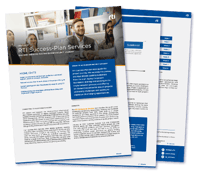RTI and Vector
Develop and test complex embedded systems with Connext and CANoe
Seamless development and validation of systems across diverse subsystems, applications and networks
Testing is a critical part of the software development lifecycle, particularly in highly-regulated industries such as automotive and medical devices. RTI Connext and Vector CANoe provide integrated frameworks for engineers to develop and test that applications function as intended and meet rigorous system requirements. CANoe analysis tools with Connext data-centric communication capabilities provide deep visibility into system behavior, message flow, and timing.
Developers can simulate and validate performance of their Connext-based system more quickly within the familiar CANoe environment, providing seamless integration of heterogeneous networks and communication protocols, enabling end-to-end system validation. This unlocks the power of intelligent and connected systems that demand high interoperability, reliability, and low latency.

Connext and CANoe deliver a comprehensive environment to simulate, develop, analyze and test embedded systems with varied communication interfaces.
Together, RTI and Vector enable:
Integrated development frameworks for design, simulation, and testing of complex and distributed systems of systems
End-to-end system visibility and validation, automated testing, and optimization of systems consisting of both DDS-based and other communication protocols
Accelerated and simplified development and testing, reduced program risks and product lifecycle costs
As automotive manufacturers accelerate the shift to Software-Defined Vehicles (SDVs), they must develop, analyze, and test across an increasingly complex system of systems.
Connext enables the required real-time, reliable, scalable data exchange and provides the DDS-based communication across SDVs, zonal architecture, and Ethernet backbones. Vector CANoe provides comprehensive simulation, analysis, and testing capabilities for automotive bus systems, including CAN, LIN, FlexRay, and Ethernet.
Together, RTI and Vector provide a way to future-proof the automotive architecture through a combined toolchain for mixed-technology environments. This supports communication and testing across current and next-generation vehicle architectures, ensuring long-term investment protection.
This supports rapid simulation, troubleshooting and testing for:
- DDS-enabled ECUs with legacy CAN-based ECUs
- Hardware-in-the-Loop (HiL)
- Software-in-the-Loop (SiL)
The RTI Connext Integration Toolkit for AUTOSAR provides developers with code generators, runtime components, and examples to integrate DDS™ connectivity in their AUTOSAR designs. Through the Connext Drive databus, developers can directly transfer data between simulated and actual hardware components. This saves dozens of hours of custom development work, reducing project costs while preserving performance and AUTOSAR methodology alignment.
The toolkit helps OEMs in their step-wise approach toward SDV development by providing the communication link between AUTOSAR and non-AUTOSAR components. For more information about RTI and AUTOSAR integration, please visit our webpage.
Together, Connext Drive and CANoe enable:
- Comprehensive analysis and debugging that scales from embedded controllers to high-performance compute units
- A combined toolchain that supports both current and next-generation vehicle architectures
- End-to-end system validation of DDS-based applications to traditional networks
- Shorter, faster feedback loop via a consistent data model
- Rapid troubleshooting and optimization of both DDS and CAN-based communication
The growing complexity and interconnectedness of modern MedTech systems increases the potential failure modes of the device and requires systems be designed to meet demanding performance, reliability, and functional requirements across use cases and operational states. Design failures can lead to safety issues, longer product lifecycles, and costly remediation and maintenance activities after products are deployed.
RTI and Vector provide an integrated approach to accelerate device development and testing of interoperable applications and systems.
Connext provides the data-centric connectivity foundation for adaptable and scalable system architectures across new and legacy applications spanning surgical robotics, imaging, and patient monitoring solutions. Vector CANoe provides a comprehensive tool suite for automated testing and simulation across a variety of transport protocols. By using CANoe in a distributed system with Connext, product teams can efficiently design, simulate, and verify their applications and systems across development stages, leveraging state of the art technologies and tools, lowering program risks, and reducing product lifecycle costs.
Learn more about RTI solutions for next-gen healthcare systems here.
Looking for more? Check these out:
DDS, CANoe and MedTech Devices: A Developer's Guide
Vector's view on how MedTech developers can unlock the potential of DDS implementations.
CANoe and DDS
Simulate and Test DDS Applications Faster and more efficiently with CANoe.DDS, integrated with RTI Connext.
 Success-Plan Services
Success-Plan Services